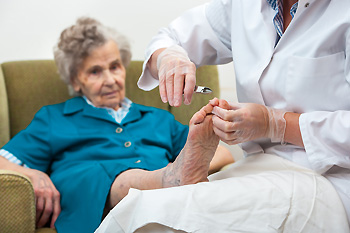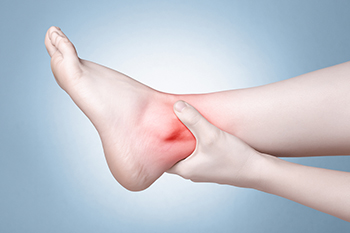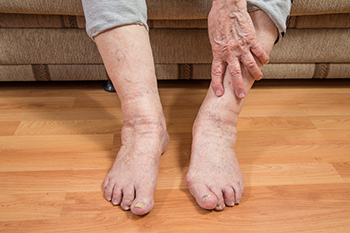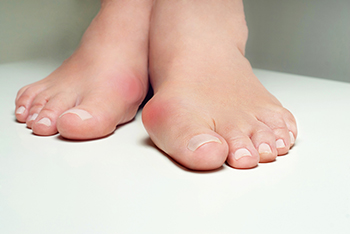Connect With Us
Blog
Items filtered by date: June 2022
Caring for Elderly Feet

As people age and the skin loses its thickness and elasticity, it can become harder to take care of their feet. Because it gets harder to bend and inspect elderly feet, caregivers often assume the role of elderly foot care. This can be a daunting task if the one cared for is embarrassed that they cannot do this for themselves and resist help. The key things to look for regarding an older person’s feet are signs of infection, such as discolored nails, blisters, cracked skin, or bleeding sores and wounds. Clean and dry the feet thoroughly each day. Toenails should be kept at a short length to avoid breaking, snagging on clothing, or scratching the skin. Look for ingrown toenails or hangnails, moisturize the feet, and make sure the elderly person wears shoes that fit properly. Footwear should also provide adequate cushioning and support for the feet, and fasten securely. Socks should not be too tight. If circulation is an issue for an older person a warm foot bath might be employed to help with blood flow and relieve tired, achy feet. If infections or problems with an older person’s feet are noted, a quick response and contacting a podiatrist can prevent a foot health crisis. A podiatrist can properly diagnose, treat, and provide prevention tips on caring for elderly feet.
If you need your feet checked, contact Ronald Pieroni, DPM of Bolingbrook Foot and Ankle Center. Our doctor will attend to all of your foot and ankle needs and provide you with quality treatment.
Geriatrics and Podiatry
When people age, some common issues that may occur are bone density loss, dry skin, poor circulation, and rough brittle nails. These issues may also affect your foot health if the necessary steps are not taken to alleviate the problems.
It is important to take care of your feet because feet that are injured or diseased can affect your overall health. Having painful feet hinders your ability to do daily activities or may decrease your willingness to do the things that you need to do.
Visiting Your Geriatrician
As we age, health problems become more likely, so it is essential to visit your doctor for check-ups to ensure that you are doing the best you can to take care of your health. It is recommended to check your feet frequently for any possible cuts, bruises, swelling, corns or any other irregularities.
Taking Care of Elderly Feet
Cracked or dry feet can be treated by applying moisturizer often. It is also important not to wear old socks because the older the sock is, the higher the possibility there will be that there is bacteria there. Wear fresh socks and make sure they fit properly.
Proper foot health means that you can have a more active lifestyle and you will not be bogged down by pain. Foot health also leads to good circulation, which is paramount for overall health.
If you have any questions, please feel free to contact our office located in Bolingbrook, IL . We offer the newest diagnostic tools and technology to treat your foot and ankle needs.
We Can Treat Your Foot or Ankle Pain
Causes of Pain in the Front of the Ankle

A pain that is felt in the front of the ankle is known as anterior ankle pain. It can happen suddenly, called acute onset, or gradually, usually as the result of overuse. The three main forms of anterior ankle pain are tibialis anterior tendonitis, ankle impingement, and high ankle sprain. When the tendon that connects the tibialis anterior muscle to the ankle becomes inflamed, the resulting condition is termed anterior tibialis tendonitis. Pain occurs when you flex your foot and toes. Ankle impingement is the result of a bony growth at the front or back of the ankle that inhibits your normal range of motion. The tissue becomes pressed between the bones, causing pain. The condition is often caused by a sprain or other injury that has not healed correctly. A high ankle sprain is the result of a tear in the tibiofibular ligament where it connects with the ankle. It causes pain, swelling, bruising, and walking becomes difficult. If you are experiencing pain in the front of your ankle, it is wise to see a podiatrist who can perform tests to pinpoint the exact cause and recommend the proper treatment to bring you relief.
Ankle pain can have many different causes and the pain may potentially be serious. If you have ankle pain, consult with Ronald Pieroni, DPM from Bolingbrook Foot and Ankle Center. Our doctor will assess your condition and provide you with quality foot and ankle treatment.
Ankle pain is any condition that causes pain in the ankle. Due to the fact that the ankle consists of tendons, muscles, bones, and ligaments, ankle pain can come from a number of different conditions.
Causes
The most common causes of ankle pain include:
- Types of arthritis (rheumatoid, osteoarthritis, and gout)
- Ankle sprains
- Broken ankles
- Achilles tendinitis
- Achilles tendon rupture
- Stress fractures
- Tarsal tunnel syndrome
- Plantar fasciitis
Symptoms
Symptoms of ankle injury vary based upon the condition. Pain may include general pain and discomfort, swelling, aching, redness, bruising, burning or stabbing sensations, and/or loss of sensation.
Diagnosis
Due to the wide variety of potential causes of ankle pain, podiatrists will utilize a number of different methods to properly diagnose ankle pain. This can include asking for personal and family medical histories and of any recent injuries. Further diagnosis may include sensation tests, a physical examination, and potentially x-rays or other imaging tests.
Treatment
Just as the range of causes varies widely, so do treatments. Some more common treatments are rest, ice packs, keeping pressure off the foot, orthotics and braces, medication for inflammation and pain, and surgery.
If you have any questions, please feel free to contact our office located in Bolingbrook, IL . We offer the newest diagnostic and treatment technologies for all your foot care needs.
Foot Structure and Skin May Change in Elderly Feet
 Many elderly people endure foot pain, which may impact mobility and completing daily activities. Research has shown there may be increased soft tissue stiffness in the foot, in addition to having a limited range of motion as one ages. With advanced age, the foot can lose overall strength and may become protonated as a result of reduced joint mobility. The risk of falling may increase, foot pain may develop, and it may be difficult to complete weight bearing activities. Approximately one in five people lose the ability to leave their house because of devastating foot pain. The skin may change thickness, and can add friction to the feet while walking. Recent reviews have confirmed the overall loss of elastin, which can result in thicker and dryer skin on the skin. In summation, the skin condition and foot structure may change in elderly feet, and may cause foot conditions that did not exist in their youth. If you would like more information about how the feet change as the aging process occurs, please consult with a podiatrist.
Many elderly people endure foot pain, which may impact mobility and completing daily activities. Research has shown there may be increased soft tissue stiffness in the foot, in addition to having a limited range of motion as one ages. With advanced age, the foot can lose overall strength and may become protonated as a result of reduced joint mobility. The risk of falling may increase, foot pain may develop, and it may be difficult to complete weight bearing activities. Approximately one in five people lose the ability to leave their house because of devastating foot pain. The skin may change thickness, and can add friction to the feet while walking. Recent reviews have confirmed the overall loss of elastin, which can result in thicker and dryer skin on the skin. In summation, the skin condition and foot structure may change in elderly feet, and may cause foot conditions that did not exist in their youth. If you would like more information about how the feet change as the aging process occurs, please consult with a podiatrist.
If you have any concerns about your feet, contact Ronald Pieroni, DPM from Bolingbrook Foot and Ankle Center. Our doctor can provide the care you need to keep you pain-free and on your feet.
Biomechanics in Podiatry
Podiatric biomechanics is a particular sector of specialty podiatry with licensed practitioners who are trained to diagnose and treat conditions affecting the foot, ankle and lower leg. Biomechanics deals with the forces that act against the body, causing an interference with the biological structures. It focuses on the movement of the ankle, the foot and the forces that interact with them.
A History of Biomechanics
- Biomechanics dates back to the BC era in Egypt where evidence of professional foot care has been recorded.
- In 1974, biomechanics gained a higher profile from the studies of Merton Root, who claimed that by changing or controlling the forces between the ankle and the foot, corrections or conditions could be implemented to gain strength and coordination in the area.
Modern technological improvements are based on past theories and therapeutic processes that provide a better understanding of podiatric concepts for biomechanics. Computers can provide accurate information about the forces and patterns of the feet and lower legs.
Understanding biomechanics of the feet can help improve and eliminate pain, stopping further stress to the foot.
If you have any questions please feel free to contact our office located in Bolingbrook, IL . We offer the newest diagnostic and treatment technologies for all your foot and ankle needs.
Effective Stretches for Bunions

Bunions affect many people around the globe. They are considered to be a deformity, and can develop from wearing shoes that do not have adequate room in the toe area. Additionally, people who rarely stretch, receive massages, or exercise their feet may be prone to developing a bunion. Many family members may get bunions, and this can come from genetic factors. They appear as a bony protrusion that forms on the side of the big toe and can cause the need to purchase larger shoes. Large bunions can produce pain and discomfort, and mild relief may be found when specific exercises are performed. An effective stretch for the toes consists of rolling a tennis ball on the sole of the foot underneath the toes. This may help to release existing muscle tension. The toes can increase mobility by gripping the foot between the toes with the hands and moving the toes back and forth. If you have this ailment, and would like additional information about how to treat bunions, please contact a podiatrist who can offer you correct treatment techniques.
If you are suffering from bunion pain, contact Ronald Pieroni, DPM of Bolingbrook Foot and Ankle Center. Our doctor can provide the care you need to keep you pain-free and on your feet.
What Is a Bunion?
Bunions are painful bony bumps that usually develop on the inside of the foot at the joint of the big toe. As the deformity increases over time, it may become painful to walk and wear shoes. Women are more likely to exacerbate existing bunions since they often wear tight, narrow shoes that shift their toes together. Bunion pain can be relieved by wearing wider shoes with enough room for the toes.
Causes
- Genetics – some people inherit feet that are more prone to bunion development
- Inflammatory Conditions - rheumatoid arthritis and polio may cause bunion development
Symptoms
- Redness and inflammation
- Pain and tenderness
- Callus or corns on the bump
- Restricted motion in the big toe
In order to diagnose your bunion, your podiatrist may ask about your medical history, symptoms, and general health. Your doctor might also order an x-ray to take a closer look at your feet. Nonsurgical treatment options include orthotics, padding, icing, changes in footwear, and medication. If nonsurgical treatments don’t alleviate your bunion pain, surgery may be necessary.
If you have any questions, please feel free to contact our office located in Bolingbrook, IL . We offer the newest diagnostic and treatment technologies for all your foot care needs.

